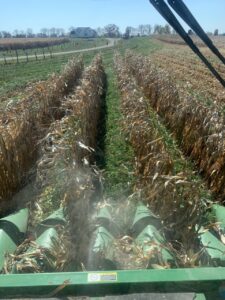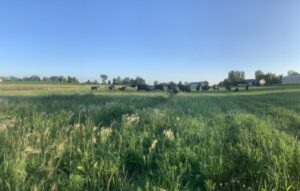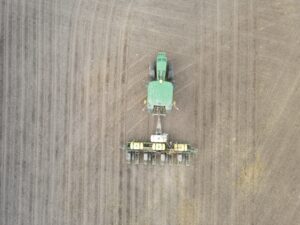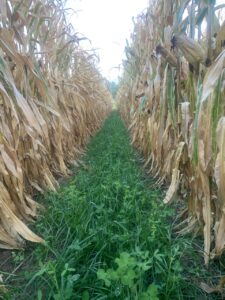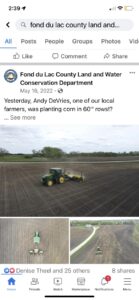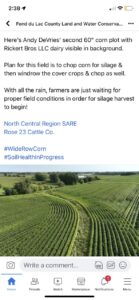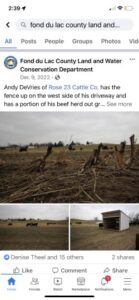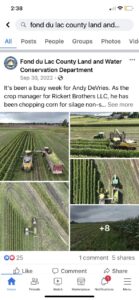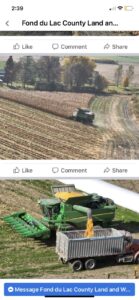Final report for FNC22-1322
Project Information
Here at Rickert Brothers Dairy we run roughly 1800 acres of corn, beans, wheat and alfalfa. We milk 950 cows with close to 2000 head total. Our ration consists of 65% home grown feeds. The farm his been family owned since 1937, in 2000 we expanded from 125 cows milked in a stanchion barn to 400 in a parlor, then in 2009 we expanded to 950 milking cows. With that many animals, manure is thee biggest factor in our tillage practices. We typically cover 1200 of the 1800 acres a year in manure, whether liquid or pen pack. Of that 1200 acres 600 acres of it is either low disturbance or no disturbance. For the last 5 years we have broadcasted rye or wheat as a cover crop in the fall and then injected our manure. It works rather well, gives us a snow catch and it captures nutrients that may leach if the plants were not there. The challenging part is in the spring, if it is a wet spring getting in to either spray or til the cover crops can be challenging. It would be nice if I could no til, however with the direct inject manure hose system, they do not run with the corn rows due to the direction of the hose and is impossible! I no til roughly 200 acres of corn a year and 150 acres of soybeans. I just recently purchased a strip til bar this fall and am really looking forward to the edition.
Rose 23 is a newly started farm in 2020. With roughly 50 head of beef cattle and 20 hogs depending on the time of year. I also can not forget the 10 ducks, 20 chickens, 2 goats, and 2 donkeys! The farm is only on 40 acres of land, half of which is pasture and the other half is row crop. It has been a fun challenge to get the most out of the land. Granted it is only 3 years in, but the only purchased feed for the farm is protein for the hogs and finishing the beef steers. The cattle and hogs are pasture raised. It is not only a marketing ploy but it is honestly some of the best beef you can eat. I could forget about finishing the cattle with grain and market as grass-fed. However, my personal taste is for grain finished beef. The steers are only fed 10 pounds of grain per day the rest of their diet is pasture. I think it is a combination of the fact they are fed some grain, eat the pasture, and have lots of room to run that factors into the quality of the beef. I spring calve and even with a limited amount of grain fed can finish the beef steers in less that 18 months. Depending on crop rotation the tillable acres or in hay or corn. Pen pack manure is hauled on neighboring fields if field is in hay rotation otherwise is spread on the corn ground if it is in corn. With the edition of the strip til bar, I am going to attempt to strip til through the pen pack manure this spring, we will see what happens! Some really cool things have happened since I have started selling meat from my freezer on the farm. As a dairy farmer I really don't have that much spare time from April to December. However, rumor has started to spread on the quality of my meat, and I did many fundraisers for area youth and organizations. The picture attached shows one of the fliers. It worked out really well this last year, I volunteer my time manning the grill and supplying meat, and other organizations are able to raise funds. At first I said man this is a lot of work, but the publicity of the event helped me sell many quarters and halves of beef this year. Not to mention it is a lot of fun and some really great organizations made some great money!
I am the owner operator of Rose 23 Cattle Co in Rosendale WI, a small cow calf operation selling beef off the farm. I am also a crop manager at Rickert Brothers LLC in Eldorado, WI, a 1,000 milking cow operation. I have been doing some type of cover cropping for the last 10 years. On the dairy it is rather labor intense, it is working well, but I believe it could be improved. On the dairy I wish to plant corn in 60" rows, planting cover crops around v6. I chop the corn early, mid September, then windrowing and chopping cover crops leaving the residue and anything that will overwinter in the field. Depending on our manure strategy for the year, perhaps run a low disturbance manure applicator through in the spring or fall. For the cow calf operation I would be doing more or less the same thing, pasturing the beef, instead of mechanical harvesting. The fields for the cow calf operation will be left in continual no-till, whether it goes to wheat, hay or soybeans. I wish to build a corn planter on 60" along with no-til equipment and fertilizer and herbicide equipment on the planter itself.
- Determine if corn at 60" centers with cover crops planted between is beneficial to cropping decisions, financially and agronomically.
- Construct a corn planter that can be used for no-till with a fertilizer and herbicide system on board.
- Determine the best method of sowing/spreading cover crops into standing corn.
- Determine if this method of cropping saved, time or labor.
- Evaluate soil health and nutrients, along with increase or decrease in required nutrient inputs.
Research
The project itself, was pretty straight forward. I took a normal 8 row corn planter, removed the seed boxes from every other row. The biggest part of the "constructive" phase was adding the herbicide banding attachments to the row unit on the corn planter. I had to install an additional electric pump, herbicide lines, and the spray tips for the planter. I was hoping to use a rate controller to modify my gallons per minute, but my flow was so low I had to do it the old fashioned way. I filled the herbicide tank with water and measured how much water I caught in 30 seconds. I then converted that to gallons per minute and once again converted that to gallons per acre to get to a speed planting that correlated with herbicide gallons per acre. It turned out rather easy. I knew what I was putting out, I just had to keep the same speed while planting.
The largest and most time consuming part of the project was fence installation. With this project, I hung 30,000 feet of wire and 600 wood and metal fence posts. Finding a contractor to do it when I needed it done was impossible. I ended up having a contractor install the posts, then I along with my 3,7, and 9 year olds had some great bonding time stringing wire.
The results for Rickert Brothers Dairy were that we produced a good crop of corn silage, but that was it. The plot averaged 19 tons an acre. There was a full day hybrid on the plot and out silage season was delayed by about 10 days compared to normal. By the time we chopped the silage off there was not enough time for growth to justify cutting and chopping the cover crops. They were established, just not enough growth there to run all kinds of equipment over in order to harvest.
Rose 23 had much better results. The variety of corn planted was only a 93 day maturing variety, so very short for silage in this part of the country. I harvested silage and filled one 8' by 150' bag. The silage yielded 18 tons an acre, which for that short of a variety I was very pleased. I recently started feeding the silage mid December to the beef cattle. The most intriguing part of the project thus far is the silage data I received from my nutritionist. The silage sample I sent in is the best silage sample I have ever grown. The dry matter was at 39 with a start at 42%, a NDFD 30 of 63.3, a in situ Rumen starch (72 Hour) of 84, and a TTNDFD of 42.4. These numbers are incredible and I am in contact with silage professionals as to why.
I only chopped off about 8 acres, the remaining acres I shelled and it averaged 217 bu dry across the scale. This number blew me away as well also! When I originally started this project in spring I was hoping for 175 bu. It was interesting walking through the field prior to shelling. I like to hand shell ears and estimate yield, when I did that a week before combining I came up with 200 which I was already excited about.
On top of all these positives, maybe it is due to the mild winter weather we are having thus far, the cattle are still finding things to graze in the field. They have now been out grazing since mid November. They have not done as good of a job eating the standing corn stalks as I thought they would have. It may be due to the fact that the stalks are so thick next to one another, or it is because I'm supplementing them with the best silage I have ever grown.
Over all between the two farms Rose 23 had more success than Rickert Brothers; however, neither was a failure.
Educational & Outreach Activities
Participation Summary:
I had one field day set up with Fond du Lac County Land and Water team. We had roughly 30 people that attended the field day. A few were area farmers others I did not know and weren't from the area. We went over what the goal of the project was and how I was trying to achieve it. We walked the field, which at that point in time didn't look promising whatsoever. It hadn't rained in weeks and the cover crops were struggling. Overall, it ended up being a success with multiple people reaching out to me about the project after the field day.
I am lucky to have a county department like I do. They share passion about thinking about agriculture "outside the box". This project really blew up because of their social media. They posted updates about the project multiple times during the growing season. The unique thing about the project is I easily took 10x the questions via Facebook and online as I did at the field day.
Learning Outcomes
I have completed my 2022 60" corn trial, it was rather exciting! I had two separate fields that I trialed in, both on heavily traveled roads, and my goodness did I get phone calls asking what was wrong with my corn planter! It was a great experience, not only was it a success financially, it was also a successful learning experience for myself and community. I am going to start with experiences learned by providing bullet points, due to the fact that there are so many.
- The community does care. I had more people asking about what I had going on. Most had no agricultural experience whatsoever.
- Social media is a great avenue for showing people what you are doing and why. I partnered heavily with Fon du Lac County Land and Water, they brought drones out and were here every time there was something changing with the project. With today's technology people got to see with a birds eye view of what I was trying to accomplish instead of looking out the window.
- I had one field day at the farm and multiple other speaking events about the project that I was trying to accomplish. What I learned from these is that I am not the only one that enjoys thinking outside of the box. The field day was a great success with someone coming all the way from Canada to attend. Not only were there many locals interested, there were people from miles away.
- The great thing about this project was that it really shows that there is really no right or wrong answers to agriculture. I have received National Corn Growers awards for yield contests which is a great accomplishment, however; this project brought more pride to me than any yield contest.
- The great thing about this project is that this is something that most any row crop farmer could implement without breaking the bank. Talking with people about the project at various events agreed, and to an extent I think a few are going to try the same next crop season.
- Considering I sell my beef local, this project has really put my farm on the map with a bigger dot. I have learned that people, whether in agriculture or not, enjoy seeing something different, it intrigues them. In return my meat business at Rose 23 has benefited.
- I, as a row crop farmer, a dairymen, and a beef producer have learned that what I did with the 60" corn fits certain places, but not all. I expressed that to anyone that would ask. It worked out great on the beef side of things, rather excited to put the numbers on paper. The dairy side it was not a failure by any means just not as large of a success.
- Pertaining to social media and talking to other farmers and ranchers, I went from playing around with a project to being a full-blown professional in 6 months. Many people have asked far and wide what I did, how I did it, and what I would do different. I responded to all, just telling everyone to take it with a grain of salt, that what worked for myself might not work for them and it may not work for me next year.
Project Outcomes
There are two local beef farmers that were very excited about this project. They contacted me when I planted the corn, then the cover crops. Most important to them, and myself, they wanted to see harvest data. One of the farmers I knew, but not on a first name basis. We have really turned into rather great friends due to this project. He has the same mentality as myself about thinking outside the box. He now randomly pulls in my driveway to check out the beef cattle out grazing in the field, and wants me to custom plant a few acres for him to try as well next year.
There is no doubt in my mind the project was a success, with that said, I have many things I wish to change next year!
I planted 60" inch corn, but it wasn't a true 60" and I did this on purpose. What I did was just shut off every other row on the corn planter. So when I was planting back and forth, I had corn at 60", 30", and 90". Pre-harvest it was amazing to see the cover crop growth in the 3 different row widths. The 90" cover crop was a solid 8-12" taller than the 60". There was virtually no growth in the 30" corn. When it came to harvest, I harvested a few rows, row by row.

